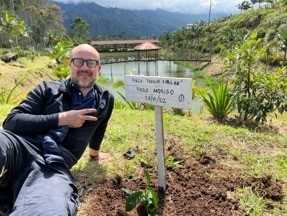MILAN, Italy – Coffee expert Andrej Godina interviewed Accenture’s Paolo Andrigo during the Aromateller Expert journey at the Slow Food Las Capucas Sustainable Coffee Village plantations in Honduras. The B.farm Aromateller Expert training course is a stimulating journey of discovery across the coffee production chain in the producing countries. During the trip in November 2022, we had the opportunity to talk about key coffee supply chain issues with Paolo Andrigo, a Director at Accenture.
Andrej Godina interviews Paolo Andrigo
Paolo is an expert with extensive experience in the digital transformation of Consumer Goods companies and in growth opportunities in the Food Service industry.
This was Paolo’s first time visiting a coffee plantation and he was excited to discover how, phase by phase, growers produce coffee. The idea behind the Aromateller Expert journey is to give participants a hands-on, immersive experience of what it takes to produce exportable coffee, from seedling to shipping.
At the experiential production laboratory, participants walk through each of the different phases, learning about planting the seedlings in the nursery, transferring them to an open-air plantation, harvesting the fruits, and processing the beans. They also receive technical training on coffee quality control and cupping.
Technology and coffee supply chain
Andrej Godina, coffee expert: “During the different workshops Paolo attended in Honduras, we had the opportunity to exchange ideas on technology applied to the lengthy coffee supply chain.
At its Slow Food Las Capucas Sustainable Coffee Village, the Capucas cooperative has well over 900 members who produce high-quality commercial coffee and specialty micro-lots, paying special attention to sustainability and product social responsibility. My interview with Paolo focuses on what happens during coffee processing at wet and dry mills.
Before we begin, let’s lay out what these terms mean. A wet mill is a plant that processes the freshly harvested coffee cherries to ultimately obtain the green dry parchment. On the other hand, a dry mill is generally operated by an exporting company to mill the dry parchment or decorticate the dry cherry skin and select the best beans for export based on commercial classifications.”
Paolo, let me start by asking you how you think new technologies might be applied to the coffee production chain in the production countries, from nursery seedling to shipping for export?
Paolo Andrigo: “Here in Honduras, I’ve been able to touch with my own hands each of the links in the production chain, both small and large. At the moment, there are different levels of digital maturity along the chain. In some cases, such as here in the Slow Food Las Capucas Sustainable Coffee Village, the level of applied technology is already impressive. And some U.S. companies are building on this by equipping cooperative mills with machines that gather data which they can then use to evolve their proprietary blockchain technologies to promote shared and sustainable growth.
At the Capucas wet mill, for example, the use of image recognition to select cherries by color has reached an optimum level. The machine uses high-quality optics to scan each cherry and discard the ones that fall outside the predefined color range. We saw that changing the drupe selection parameters led to visibly different results.
This means that an average harvest on the plantation can be corrected in the wet mill to better match the target end product. To produce a good commercial coffee, the cherry selection is less precise but for a specialty coffee, all the cherries must have the same perfect color as the ripe fruit.
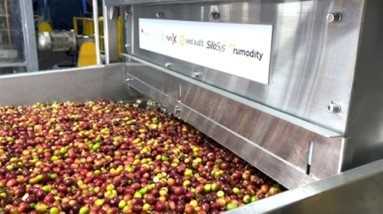
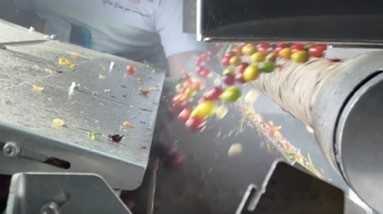
Watch the video showing the optical coffee cherry selection process:
What’s more, applying this technology to the harvested cherries makes it possible to obtain extra data such as, for example, the percentage of cherries discarded based on the instructions given to the harvesters, the number of cherries needed to achieve a given weight/volume or the relative size and density of the fruits. Lastly, optical sorting is also versatile: it can be used not only for botanical varieties that ripen red but also for those that ripen yellow, orange, and pink.”
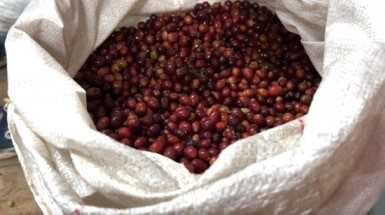
Can the data gathered by this type of technology be used easily?”
Paolo Andrigo: “When IoT (Internet of Things) technology is applied to the production machines, real-time data can be gathered at both dry and wet mills to monitor the quality of the coffee along the production pipeline. For instance, the connected scales used in the wet mill monitor the real-time weight of the cherries and the dry parchment obtained at the end of the process.”
“Blockchain, too, is changing the way of working in the industry and the relationship between the wet mill and individual farmers. The wet mill operator can now pay a farmer with a simple click by leveraging the Blockchain platform and the certified information that the parties have shared. This allows farmers to decide whether to be paid upon delivery or wait until after the coffee has been processed and be paid based on the cup quality —in which case the earnings may be higher if the cup quality is superior.”
“A further step of Blockchain integration that companies are currently implementing relates to bag traceability. Tags and antennas installed on the plant and in the warehouses enable real-time tracking of the coffee from the plantation to the factory and certification of both origin and quality.”
“One of the many activities carried out at the wet mill is “cupping” which establishes the sensory quality of each batch of coffee. Today, all tasting sessions are transcribed manually. If an App were used, it would allow the mill to gather real-time data and track each session and tester.”
Cupping and drying process
There already exist different apps that support tasting laboratory operations, including cupping. The Crospter.com platform is one example: it can help laboratories to simplify and digitize their activities.
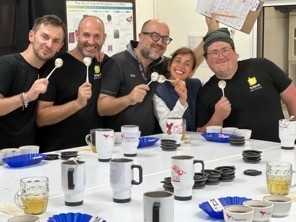
During the drying process, sensors could be deployed to enable greater control over the temperature. Operators could regulate hot air flows based on parameters such as external temperature and humidity and enable a more precise and faster drying process.
Automation systems in greenhouses for drying temperatures and air flows combined with a solar panel power system and batteries could enable significantly more reliable process management and enhanced coffee cup quality.
Paolo Andrigo: “Once data are collected in the wet mill, there must be a team in place to look at the analytics and take data-led actions. Data Governance and Change Management are two key requirements for successful business transformation.”
“After the drying process has been completed, the product is ready for transfer to the dry mill.”
“As part of our journey, we had the chance to visit the plant in Santa Rosa de Copan which is also owned by the Capucas cooperative. Here, all the machines are connected to an IoT Solution.”
“The machine that is used to optically select the milled beans also has the capability to scan the color and shape of the beans and reject the ones that do not meet the preset quality standard (defects quality management).”
“Many companies are currently developing their own applied blockchain solutions, spreading energy and investments across different players.”
“Since blockchain continues to gain ground in the food industry including in the coffee segment, in my opinion now is the time to strengthen the culture of data sharing among the different operators along the supply chain. The technology exists and what we need to do is work on supply chain and commercial agreements to improve quality and sustainability.”
Technology and data collection
We have looked at what happens in the coffee processing steps in the wet and dry mill. Now let’s turn our attention to technology in the plantations as regards data collection, automation and sustainability. The coffee plantation is probably the weakest link in the supply chain in the producing countries because they tend to be family-run companies that cultivate no more than between three and five hectares.
Their agricultural practices are generally quite good but certainly not yet cutting edge. In the specific case of the Slow Food Las Capucas Sustainable Coffee Village, agriculture is fully organic and biodynamic fertilizers are used to keep the soil in top condition.
Paolo Andrigo: “Certain agricultural aspects can be improved, especially in relation to soil analyses where there are opportunities to create personalized fertilization solutions. This is why each local cooperative should have its own independent analysis laboratory. Furthermore, the application of new live analysis technologies of the plant leaves could provide the farmers with valuable information and help them take more targeted action, faster. Sensors and a dedicated App could be used for more precise control of the roja, while drones could continually monitor the conditions of the plants.”
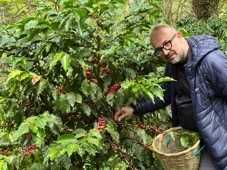
Improvement of the coffee sector thorugh technology
A bottom-up piping system for irrigation and roja control would provide a low-cost fertilization system once the initial investment for the piping has been addressed. This, in turn, could facilitate interesting experiments around plantation management systems and perhaps even pave the way to doubling or even tripling the current number of harvests. Having more than one harvest per year would be an attractive proposition for farmers, freeing them from the constraints of seasonal work and ultimately achieving year-round operations.
Paolo Andrigo: “How can technology improve coffee harvesting? One example would be the adoption of glass viewers to show the pickers exactly which cherries to gather. This would greatly improve the quality of their work and help ensure that non-mature leaves are left on the plants. Viewers with geolocation capabilities could keep a plant-by-plant harvest history of the plantation and give pickers a precise picking path to follow based on the ripeness stages of the drupes.”
“We could call it “picking route optimization”. RFID tags applied to each individual basket at the time the leaves are gathered would provide traceability to specific plants in a production lot, making it possible to monitor the quality and quantity of the leaves gathered on a given picking path by individual pickers as well as the weight of the drupes gathered.”
Andrej Godina: “Thank you, Paolo, for these valuable insights. I hope that applying new technologies in the countries of origin will soon help the coffee production chain become more sustainable for farmers.”




